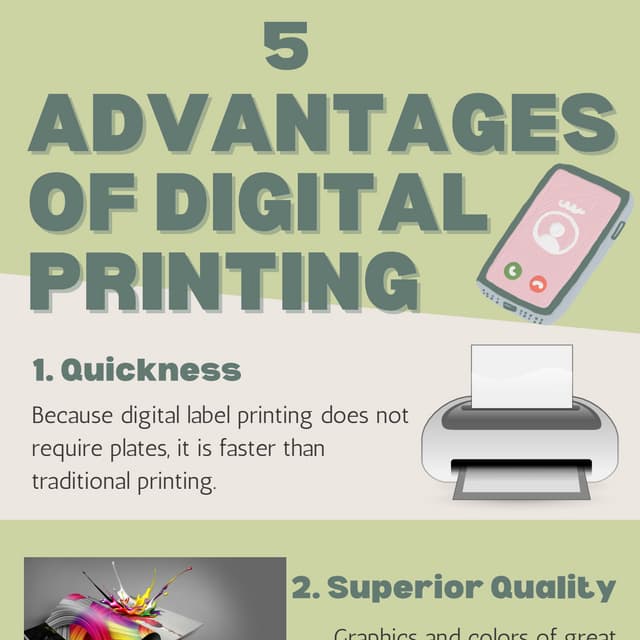Indicators on Digital Printing You Should Know
Digital Printing Things To Know Before You Get This
Table of ContentsWhat Does Digital Printing Mean?Unknown Facts About Digital PrintingDigital Printing Things To Know Before You Get ThisGetting My Digital Printing To WorkSome Known Details About Digital Printing An Unbiased View of Digital Printing
Variable data printing, such as straight mail with customized codes and addresses, is ideally fit for electronic printing. Digital quick printing just needs 4 actions of design, evaluation, printing and binding to obtain everything done. Digital quick printing has an unrivaled benefit: print on need.According to PMMI, digital printing enables brand names and manufacturers to react promptly to client needs while enhancing the supply chain, decreasing warehousing cost and waste, and enjoying faster time to market. That all audios fantastic, however how does this innovation do all that? The major differentiator of these technologies is that there are no set-up charges and no plates with digital printing.
Indicators on Digital Printing You Need To Know
According to Wikipedia, the best difference between digital printing and traditional techniques such as lithography, flexography, gravure, or letterpress - Digital Printing is that there is no demand to replace printing plates in digital printing, whereas in these analog printing methods the plates are repetitively replaced. This causes quicker turn-around time and decreases price when utilizing electronic printing.
Fast manufacturing indicates obtaining your product to market faster. It also means it's easier and faster to make adjustments later, when you alter a dish, add a SKU, or develop seasonal product packaging. Digital printing is extremely flexible, so it's easy to make changes to the plan style rapidly. Everything goes back to home plates.
More supply can suggest more waste down the roadway. With standard printing approaches, short-run printing is simply not feasible. Since a terrific layout can make or damage your item, electronic printing consistently creates high-quality, clear and colorful graphics each time. Digital printing on flexible pouches adds the brilliant, vibrant, and specific graphics that practically bid consumers to reach out and touch them.
Digital printing is the procedure of printing digital-based photos straight onto a variety of media substrates. There is no need for a printing plate, unlike with balanced out printing. Digital documents such as PDFs or desktop posting documents can be sent out directly to the electronic printing machine to print on paper, photo paper, canvas, textile, synthetics, cardstock and other substrates.
The Buzz on Digital Printing
According to PMMI, digital printing permits brands and suppliers to react promptly to client demands while boosting the supply chain, minimizing warehousing continue reading this cost and waste, and delighting in faster time to market. That all great post to read sounds wonderful, however how does this modern technology do all that? The significant differentiator of these innovations is that there are no set-up fees and no plates with digital printing.
This results in quicker turn-around time and lowers price when using electronic printing.

Facts About Digital Printing Uncovered
With conventional printing approaches, short-run printing is just not possible. Because a wonderful design can make or break your item, digital printing regularly produces premium, clear and colorful graphics each time.

According to PMMI, electronic printing allows brand names and makers to respond quickly to consumer demands while improving the supply chain, lowering warehousing cost and waste, and delighting in faster time to market. That all audios fantastic, yet how does More Info this technology do all that? The significant differentiator of these modern technologies is that there are no set up fees and no plates with electronic printing.
Digital Printing Can Be Fun For Anyone
According to Wikipedia, the best difference in between digital printing and conventional techniques such as lithography, flexography, gravure, or letterpress is that there is no need to replace printing plates in digital printing, whereas in these analog printing approaches home plates are repetitively replaced. This causes quicker turn-around time and lowers price when utilizing digital printing.
Quick production suggests getting your item to market quicker. It also indicates it's much easier and faster to make changes later, when you alter a dish, add a SKU, or create seasonal packaging. Digital printing is very adaptable, so it's simple to make changes to the bundle design swiftly. It all goes back to home plates.

The Definitive Guide to Digital Printing
Digital printing is the process of printing digital-based photos directly onto a range of media substratums. There is no need for a printing plate, unlike with balanced out printing. Digital data such as PDFs or desktop publishing data can be sent out directly to the electronic printing machine to print theoretically, image paper, canvas, fabric, synthetics, cardstock and various other substrates.